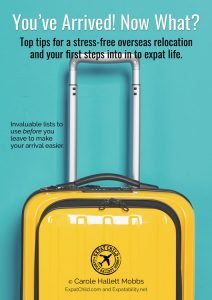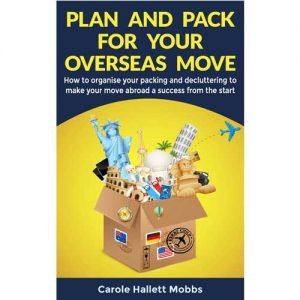Packing for a move overseas
One of the least exciting parts of moving abroad, but the most necessary, is the packing and shipping of all your belongings to your new country.
When you have to do this with kids around, it can be a complete nightmare! Attempting to de-clutter and pack efficiently, without causing upset, is a tricky game to play. Who’d have thought that the dog-eared old teddy you discover stuffed at the back of a cupboard will suddenly become your child’s most prized possession?
Who, what, when where, and why of packing
AKA, the five Ws, much beloved of all project managers. And planning your packing for your move abroad is most definitely a project. It’s not just all about what to pack and what to leave behind, either; you’ve also got to tackle when and where each item goes. And who will help you move all your gear to your new home abroad. I’m also going to add in one H… how to pack.
Oh, there’s a ‘W’ missing… the why. Why on earth did I write a whole book on packing?
Well, mainly because the whole process drives me crazy-stressed. My book started as some notes to help me rationalise the packing for one of our moves and kind of escalated from there. So, now I pass my tips onto you to help you feel less stressed.
Briefly, for all the moves I’ve made with my family, I have been the one who deals with the whole packing aspect – and it goes without saying, I need to do this while also dealing with day-to-day life, school runs, child and pet wrangling, feeding everyone etc etc. So, yeah, crazy-stressy.
We have a clear sequence of four packing targets, in this chronological order: shipping container, unaccompanied air freight, luggage and hand luggage. If something doesn’t get into the container, it ends up in air freight. Anything missed from air freight goes into the suitcases and ditto for the hand luggage… the hand luggage often ended up as ridiculously over-stuffed and heavy!
You may be one of those people who move overseas with a couple of suitcases. In which case, this article isn’t really for you! This is for families with ‘stuff’. Yes, you could ditch it all and buy everything new in your new country, but I don’t really advise this. Apart from the cost, the time involved, and the energy expended in repurchasing everything (do you really want to go and buy all your saucepans, plates and so on again?), it is your ‘stuff’ that makes a house a home.
Your ‘stuff’ is made of memories. Now, I’m not particularly sentimental – I don’t hold onto boxes of baby clothes, for example. I don’t have my school reports, or my daughter’s for that matter. I do, however, have a lot of knick-knacks – ornaments and collectibles – gathered over many years, that hold lots of wonderful memories for me. No way would I dump all these. Having said that, it is easier to buy kitchen equipment than it is to buy memories, so if you must make a choice, choose memories.
10 steps to practically plan your move
So, where and when to start? Start as soon as you know you’re moving abroad. Whether that’s two years in advance or two months, start the declutter and planning immediately.
A basic order in which to do all this is:
- Declutter: it takes far longer than you imagine.
- Paperwork: if you’ve lived in the same home for years, the paperwork really builds up. However ‘digital’ you are, there will still be paperwork. Birth certificates, medical records, financial agreements, all sorts. Start now.
- Find a removal company: this could go at either point 1 or 2, depending on how long before you move.
- Plan your packing groups:
- Shipping
- Air freight (if using)
- Luggage (going with you on the plane)
- Hand luggage
- Prepare for the in-home survey AKA the removals estimate
- Arrival packing: Work out what you will need on arrival, because this needs to be packed too.
- 2-3 weeks before the packers arrive
- A day or two before packing day
- Packing day (eek!)
- And UN-packing day. Phew!
Decluttering
Clearing the clutter can take ages. And for many, can be difficult, emotional and stressful. A couple of quick tips to help remove the emotion from the process: firstly, be ruthlessly honest – when did you last wear it or use it? If over a year ago, get rid.
The absolute key phrase that works for me is, “Do I want to keep this?” Just keep repeating that with each item. Do not say, “Do I want to throw that away?” because the answer will always be “No!”
The nearer you get to packing day, the more ruthless you’ll be – which doesn’t always have a good outcome. Even now I can spend ages looking for a book I just know I have, only to realise I rashly gave it away a couple of moves ago. Another article here.
Paperwork
Ugh. Again, start as soon as you know you’re moving. Actually, start now, even if you aren’t moving. It really builds up and it’s good to keep it organised. More details in this article.
Find a removal company
Use the tool above to get free international removal company quotes and check out all my articles on this topic here.
And definitely sign up for a professional packing team. They save a huge amount of time, stress and money. They can fit more into a box than you ever can, meaning you have fewer boxes to pay for. And often, insurance will be cheaper.
The only items I suggest you pack yourself are the small ornaments you may have. I pack mine into sturdy shoe boxes or similar, which I mark clearly and tape shut. That smaller box can then be packed ‘as is’ with the rest of the room’s items. Incidentally, I do the same with my costume/inexpensive jewellery. More valuable items are carried in my hand luggage.
Plan your packing groups
This is all about prioritising. Your shipping container is usually the first deadline you’ll have. Rather than go through all this again here, you can listen to my podcast episode on this topic.
Of course, there’s my book, which goes into much more detail! And you can get ready-made packing lists here. I’ve done all the thinking for you to help save you time.
Prepare for the in-home survey
Before the shippers can properly quote for your move, they’ll need to visit your home to assess what you’re sending by ship. By this point, you will need to be clear on what you’re sending and what you’re not. How to prepare for the removals estimate. And another article on the In Home Survey here.
While I’m at this point in my 10 step list, I want to share a couple of other key points to note. Firstly, find out what you cannot take overseas, which is detailed here.
And secondly, look into whether your electrical equipment will work in your new country. You’ll need to know what the voltage is there and if your existing equipment will work. Yes, you could get step up or down transformers, but you’d need one for each item and that’s a whole heap of extra weight and hassle. Televisions may also not work, so do your research.

Arrival packing
Yes, you need to plan what to pack for your arrival. This will depend on whether you’re moving into, for example, a hotel for a few weeks or if you’ll be going into an unfurnished property. You need to pack some items to ensure you and your family get off to a smooth start in your new home country. Again, I’ve written it all out here, along with top tips on managing the first few days and weeks in your new home: Arrive Well eBook
2-3 weeks before the packers arrive
Now you’re on the actual, real countdown! The key here is to make sure every item in your home is in its proper place. So, all kitchen stuff in the kitchen; anything that’s not a book shouldn’t be on a bookcase; all clothes in the wardrobes; all toys in a toybox and so on. This will help prevent the occurrences of books being packed on top of delicate ornaments, heavy saucepans packed on top of one-of-a-kind vases… yep, been there.
Another tip is to take all your pictures and wall décor down from the walls. Stack them all in one place so they can be packed quickly and safely together. Saves a lot of time!
Try to keep on top of all this, as it can quickly unravel – especially with kids around. More tips and advice here.
A day or two before packing day
Don’t panic, just be methodical. Carry on with the above.
And keep this in mind at all times: anything that can be packed, will be packed. I mean that… If something isn’t either nailed down, hidden from view or very clearly labelled ‘Do Not Pack’ you will be in for some, often nasty, surprises when you finally unpack at the other end. Such as a full dustbin, dirty crockery and much more. Here are some more tips to help you on this final run.
Packing day (eek!)
I’ll be straight with you – this is the most stressful day. Even now, almost three years on from my last move, I still can’t bear the sound of packing tape going over a box. Check out my article here for practical tips. And stock up on wine or something!
And UN-packing day
Finally! It’s now several weeks later and you’re in your new home and your shipping container arrives. While this is nowhere near as stressful as packing day, you do need to be very on the ball. So, I recommend a stack of coffee, your packing list and quick wittedness. Look at this article for step by step guidance on how to handle this day smoothly.
Well done, you’ve made it!

To get all this information in one handy place, do please buy my book. ‘Plan and Pack for Your Overseas Move’

The packing lists are here: and don’t forget to check out the separate hand luggage lists for babies, toddlers, kids and teens.
And, I do recognise this can all be super-overwhelming. Remember, I’ve been there and done that, several times over – and I’m not a ‘two suitcases’ traveller! So, if you’re feeling overwhelmed, download my Super-Scary To Do List Buster.
And if that doesn’t help, let’s talk about it. Book a call with me and let me shoulder some of your load.
Good luck with your move!



Very good suggestions for packing tips for a family move abroad. This is a fantastic post for me because I will move away in a few months. I will take your suggestions.